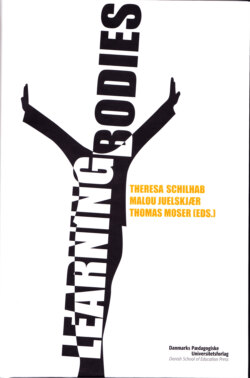Читать книгу Learning Bodies - Группа авторов - Страница 4
На сайте Литреса книга снята с продажи.
Research in learning and body
ОглавлениеIn the beginning of this decade, knowledge and interdisciplinary dialogue in the research fields of ‘learning’ and ‘body’ was sparse. Since then the field has grown, and a number of publications have seen the light of day with ambitions of drawing up a field of research.
Among the social sciences, Sociology is truly where the body has gotten and still gets the most pronounced attention (e.g. Petersen 2007). Starting with the ground breaking contributions of Bryan S. Turner (1984; a new edition in 1996) the body has been established as one of the core topics in sociology that still generates a high amount of publications (Cregan 2006; Vannini & Waskul 2006). Recently, a number of volumes containing historically significant contributions to the body issue in social science has been published (Fraser & Greco 2005; The Aberdeen Body Group et al. 2004). A few decades with continuously increasing focus on body issues have seemingly created an interest in earlier texts published before this topic became ‘hot’.
With a clear relationship to Sociology, feminist research (Fausto-Sterling 2000; Fingerson 2006; Frost 2001; Niranjana 2001; Young 2005) has significantly contributed to shed light on the body from a new perspective. Feminist research is often inspired by post modernistic perspectives (e.g. Norton 2002), but post-modern research also uses the body to question assumptions about the dominance of language, as shown by Terdiman (2005). And, as demonstrated by Moi (2005), feminist theory and research may also challenge dominant post-structuralist theories of sex and gender, providing a ‘third way’ between essentialism and constructionism.
Another hallmark in recent times is the emergence of more and more approaches that cut across traditional academic domains. Medical anthropology (Csordas 1994; Lock & Farquhar 2007; Lupton 2003; Worton & Wilson-Tagoe 2004) has traditionally had a broad and integrative view on the body, challenging a pure biological understanding of the body by questioning basic assumptions in medical science by e.g. anthropological, sociological, ethnology, philosophical and psychological means. New topics like organ transplantation (Ben-David 2005; Sharp 2006) underline the necessity to rethink the body in new ways by describing body organs as an exchangeable socio-cultural resource. Even the immune system has been analyzed in a sociocultural context (Wilce 2003) and it has been pointed out that immunity and disease may also on the biological level, be partly constituted by social processes, rethoric and politics.
Furthermore, new interdisciplinary approaches have been established between the rapidly expanding neurosciences, psychology and philosophy, especially phenomenology (e.g. Gallagher 2005; Gallagher, Pockett & Banks 2006) underlining the importance of embodiment to all kinds of cognitive processes. Recent developments in cognitive science also stress the significance of embodied actions as inextricably related to cognition and language (Gibbs 2006).
To conclude this outline of a growing field, one more interesting border-crossing approach should be mentioned: The reflexions of the body in a semiotic perspective as presented by Thibault (2004), who is trying to understand both the semiotic, discursive nature, activity and the physical context as important prerequisites for meaning-making.
